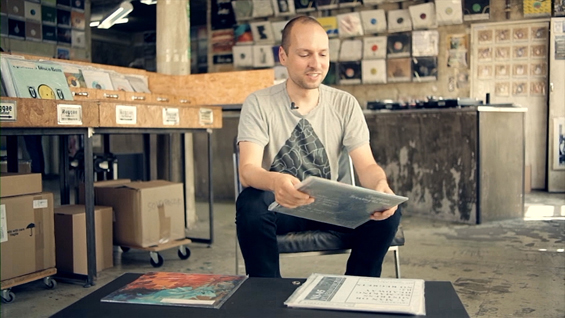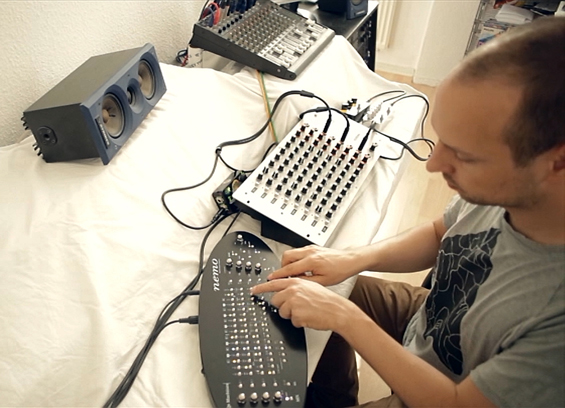

BACKTRACKING WITH STEFAN GOLDMANN'S 17:50
There are many reasons why Stefan Goldmann is one of textura's favourite artists. Rather than toeing the party line, the Berlin-based DJ-producer goes his own way, carving out an idiosyncratic path that's his and his alone. Though nominally techno, his music is distinguished by an ever-imaginative and sometimes skewed take on the form. It's definitely club music but of a distinctive kind produced by a creator who's exceptionally imaginative, endlessly curious, and, one presumes, never happier than when he's bringing a project to fruition. Ever the provocateur, Goldmann released in 2009 a version of Stravinsky's Le Sacre du printemps that was stitched together using 146 sections taken from over a dozen classic recordings of the work. Unusual juxtapositions emerge in other pieces, often as a result of the collision between “found” recordings and rhythm-oriented backdrops, such as can be heard when a choir and orchestra appear within “Lunatic Fringe” and “The Grand Hemiola,” respectively. On his latest work, 17:50 (issued on Macro, the label he founded in 2007 with Finn Johannsen), Goldmann explores the possibilities of pitch-shifting, and once again we see the techno genre being handed a novel, even subversive twist. At a purely listening level, the album is captivating, but there's also much going on below the surface in terms of production methods and ideas. How lucky we are, then, that when Goldmann was asked whether he might be willing to provide some background to the album's tracks, he generously complied. The text he's composed allows for a deeper appreciation of the work, and we are grateful to him for shedding such illuminating light on 17:50.
1. “17:50”
It used to be the intro part of “Carrion Crow,” but I split them on the CD so now there's an introduction to the mood and theme of the whole thing. Probably it is a bit misleading, because it has this acoustic shaker right away from the start (most of the drums on the album are synthetic) and then this guitar-like rock sound riff. Yet still, the strange tuning is there, the little signal-type sounds, the 16th grid. When you do music for some time you get used to certain aquired standards. Most people past twenty I know don't really change the rule set of their aesthetic preferences anymore. So do many musicians, critics, bookers, etc.—once learned, you can cling to one way of doing and evaluating things indefinitely. Sometimes I feel most things of relevance have been said once the basic concept is out. If there is something like a new or so far unknown meaning, it lies outside of our current experience. You can't quite see it before you get there. That's why I try to impose new concepts and angles on my work. It forces me to move out of my comfort zone. It also helps getting coherent groups of works (like an album) together beyond subjective groupings. A concept is like a gateway into new territory (even if it's just subjectively new), defining one aspect beyond which everything else can develop intuitively, where things can be as personal as you wish, happily mashing old knowledge with whatever new happens to us behind the gate. “17:50” is the doorstep here.
2. “Carrion Crow”
I love to do melodies, but sometimes it seems to me like we have exhausted our potential for making an impact with a hook. It's probably due to the flood of music we experienced, carrying forward all the combinations a thing can ever have. Two things got me rethinking melodies: one was listening to Chalga music, which is a kind of cheaply done Bulgarian electronic music with heavy use of “Middle Eastern” sounds via Arabian tuning presets and excessive pitch bending; the other was coming across a barrage of journalistic praise of some pretty boring, self-indulgent music based on “just intonation.” There were articles that seriously tried to make a point that even-tempered tonality sounds wrong. At the same time I did enjoy microtonal works by the likes of Ligeti and Scelsi, but felt there's little conceptual (and other) worth in reapplying the results of decades of academic reasoning to techno—a school of producing music I didn't intend to abandon. It eventually dawned on me that Chalga really held the key. It was a totally twisted combination of “found sound / readymade” (via its tuning presets) and a group effort in pushing the resulting melodies way forward by designing ridiculously cutting sounds, bold pitch bend moves, and truncated note durations. The whole production culture of it is super advanced and has this competition going on about who's going to come up with the most hilarious sound.
I went through some abstractions of it, but “Carrion Crow” holds the essence of this idea: the tuning is an Indonesian preset and the rest is “cutting” sounds I designed (using some odd synth techniques, paired with guitar effect pedal distortion units) plus playing around with the pitch bend wheel. One of the interesting effects to me is that I feel this way I can get away with super silly melodies. Like this one.
3. “Rigid Chain”
I was hooked to the idea to clash empirical tunings (as opposed to academic tuning systems) with electronic/synthetic sound. Empirical tunings are ace because they exist for a reason. They are condensed experience, they have a legacy and tell a story—very abstractly. “Sampling” this one parameter—pitch information—out of its cultural context transports a lot of meaning without the touristy associations, say, a complete Oud sample would bring. I also liked the simplicity of using preset tunings. Effort for its own sake is something for art rock and fusion jazz.
Again, the tuning was just a doorstep here beyond which I could play around, making drums sound ruff. There is a lot of specific distortion I wanted to try on drums. Another thing I love to do is to find some effect unit and appropriate its sound. The idea is to put its sound right in the center of a piece, so any other subsequent track using it will sound like this one. It's just a game of associations and ownership of ideas, outside of legal definitions—purely social / psychological; my strange version of appropriation art—hijacking a piece of mind. There is this spring reverb that has the springs on top, so you can scratch or hit them. Sounds insane, like Einstürzende Neubauten doing dub. I've seen it in a couple of producers' studios, but no one seemed to use it to its full capacities—which is to totally mishandle its springs. So I did that on “Rigid Chain,” excessively, scrubbing them with a knife and chopsticks and whatnot. That's the sound source for all those metallic scratching sounds throughout the track.

4. “The Outness Queens” / “Manila Grind”
It's rough and sweet at the same time. It also goes through different sections and builds up this spooky feel. I'm totally into darkness. I wanted to do an album that has a lot of detail but never turns slick. There are layers of sound that have quite a bit of noise in them, twisted percussive add-ons; it is never cold. In terms of form it goes through three sections—one dark introduction, one warm and welcoming middle part (with a hiss-laden bass note serving as a 4/4 pulse, trying to cut through), and a grind around a reduced nod to chalga playfulness—the theme of “Manila Grind.” It's set off against a whirling delay line interfering with the basic percussion pattern. It's something I wanted to do since hearing Sonny Sharrock's echoplex explorations on Jack Johnson. I recently made some friends from Manila, and they where curious about the title. I told them I imagined Manila nightlife to be hot and pushy and nasty, which is kind of a chalga theme—and they where like: Yeah, it is just like this. Will go and check.
5. “Adem”
Adem is the name of a gangster whose grave is located next to that of my grandparents in Sofia—no relation though. On the front side of his marble tombstone you can see his portrait engraved, looking very serious. On the back side he holds up his hands doing some gangster finger styles and looking like he just got three tons of cocaine through customs. A book I read (by Georgi Stoev) said Adem was fiercely independent and didn't give a shit about other mafia groups' street politics. That probably killed him—and the book's author too. The track has a typical “kiuchek” sound and Middle Eastern feel. For some reason, the more Middle Eastern a song gets the more it is considered dirty or nasty in Bulgarian music. Typically, lyrics go like “be quick or you'll miss the train and someone else will enter the last car's door” … that stuff always comes with the most Arabian sounding melodies.
The difference between chalga and something like rai is that chalga churns out the nastiest melodies. It's so focused. “Adem” is in this style, and you can't really understand it coming from Arabian music. It is already an abstraction or reduction. Maybe that's what it's about. “Arabian” as a cliched code. If you want real Arabian just go see Omar Suleyman. I'm more into Milko Kalaidjiev. He looks like Omar, has the most brutal “Casio orient master” melodies, and all he sings about is his dick. You know, we Bulgarians were under Ottoman rule for 500 years. As a “fuck you” we obsessed with alcohol and pork, just what the Ottomans weren't allowed to enjoy openly. Since socialism's weird emancipation program, sex got added to this—overemphasized. All of these together form chalga and it's associatively coded into melodies. It was about time to have that style in a techno track. Most of the other 17:50 tracks obscure their roots, building a more abstract melodic system within the confines of techno and house. Just like chalga, “Adem” radiates the smell of grilled pork, of rakia abuse, of pushy pick up.
6. “Dead Cat Bounce”
Pitch bending gets reduced to its very essence here—just going down sounding like meow meow… I love simplifying things, finding the core. This one is almost automatic. The action has been delegated to the metric values of looped layers of different step lengths within the 16th note grid. I think the grid is the defining element of techno. Once you leave it, many possibilities are lost, and it just sounds random. I didn't want to end up doing IDM. There's still life in the grid. Dead cat bounce.

7. “Empty Suit”
It's all about the bass, which gets a lot of its power out of the near-quartertone step which separates its two notes. That's from a Maqam scale rubbing against its even-tempered neighbour. Maqam scales don't contain actual quarter tones, but near ¾ tone steps. The “near” is important, because they don't follow a simple arithmetic division but an empirically developed design. Anyway, this one is just pumping away, and it allowed me to build a heavier track around it.
8. “Kampong Pressure”
Kampong is in natural harmonics and it's like saying “Bye bye” at the end of the journey. The bassline is circling very calmly, and one hardly recognizes its odd metre. Initially I wanted to work simultaneously with two basic ideas throughout the whole album—“scale science” (which I did) and “beat science” (which I didn't the way I had in mind initially). I like how Photek and Source Direct would refer to their beatmaking in the mid-‘90s as “science.” I tried to apply that spirit to melodies here, putting them through the twisted process of “found sound” tunings clashing with quite meticulous sound design (then again not meticulous in a way CPU junkies imagine). I can imagine doing something very similar to rhythm, but stuffing both concepts into one album would have compromised the impact of both concepts. That's why I decided to fix up rhythm quite rigidly and have that as a base over which textures and sound shapes can go to the boundaries of the grid. I'll be back.
October 2012![]()